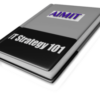This “Publishing That Matters” guide equips you with actionable strategies to craft content that resonates with CIOs, addressing their core challenges while establishing you as a trusted thought leader in the IT space.
Chief Information Officers (CIOs) stand at the crossroads of business strategy and technological innovation. They’re constantly striving to stay ahead of emerging trends—from the rise of cloud computing and AI solutions, to addressing cybersecurity threats and managing complex digital transformations. These high-stakes challenges make their roles uniquely demanding and often time-sensitive.
Amid this whirlwind of responsibility, CIOs turn to thought leaders and expert consultants for fresh insights, proven best practices, and forward-thinking solutions that can give them a competitive edge. Consequently, publishing content that addresses their pain points isn’t merely a way to gain attention—it’s a powerful medium to engage them, build trust, and ultimately influence their decision-making process.
This article is specifically designed to help consultants craft compelling, CIO-focused content—whether in the form of long-form articles, insightful blog posts, or engaging presentations. Through practical tips and best practices, it will illustrate how to connect with CIOs’ real-world challenges and create content that drives tangible impact.
In addition, we will highlight how the CIO Portal serves as the ideal platform to reach and engage with this vital audience. By leveraging the site’s publishing features—articles, blogs, and presentations—and tapping into its well-established network of IT executives, you can solidify your thought leadership, gain visibility, and most importantly, provide the actionable guidance CIOs seek in today’s complex IT landscape.
Who Is the CIO?
CIOs wear many hats and wield significant influence within an organization. They’re responsible for overseeing technology strategy, ensuring operational efficiency, and aligning IT efforts with broader business objectives. This means their role extends beyond traditional IT management—they’re pivotal in shaping digital transformation efforts, optimizing budgets, and managing talent in a competitive landscape.
Some of the key pressures CIOs face include:
- Digital Transformation: Driving company-wide innovation initiatives while balancing risk and reward.
- Cybersecurity: Protecting critical data and infrastructure against increasingly sophisticated threats.
- Budgeting: Demonstrating tangible ROI for technology investments in the face of cost constraints.
- Talent Management: Attracting and retaining skilled tech professionals amidst talent shortages.
Because of these wide-ranging responsibilities, CIOs are constantly seeking insights and solutions that help them navigate complex technological and business challenges.
What Are Their Pain Points?
In a world where the pace of innovation never slows, CIOs’ challenges tend to revolve around real-world problems like:
- Aligning IT with Business Strategy: Ensuring every IT initiative contributes to business goals.
- Justifying IT Spend: Demonstrating cost-effectiveness and ROI to executive leadership.
- Managing Tech Talent: Balancing skill gaps, recruitment, and upskilling within budget and time constraints.
- Staying Current with Emerging Technologies: Knowing which new tools or platforms will truly add value, and which are hype.
When creating content for CIOs, focus on actionable, data-driven insights that deliver clear solutions to these pain points. By pinpointing their specific challenges and presenting evidence-based recommendations—preferably backed by examples or case studies—you’ll position yourself as a trusted advisor who understands their world.
Why Should You Speak Their Language?
CIOs operate at the intersection of technology and business outcomes, so they expect communications that are concise, strategic, and ROI-focused. Speaking their language involves:
- Using Industry Terminology and Metrics: Leveraging terms like TCO (Total Cost of Ownership), ROI (Return on Investment), and NPV (Net Present Value) shows that you understand both the technical and financial sides of IT initiatives.
- Brevity and Clarity: CIOs are pressed for time and often skim through information. Short, well-structured content, supported by clear visuals or bullet points, is more likely to hold their attention.
- Strategic Insight: Go beyond surface-level information. Demonstrate thought leadership by making strong, defensible recommendations and connecting them to broader business objectives.
By tailoring your content to their mindset and day-to-day challenges, you increase the likelihood of engaging them and offering valuable guidance that resonates in their high-pressure environment.
The Pillars of Valuable CIO-Focused Content
1. Relevance
Any content aimed at CIOs must have a clear, strategic connection to the core IT and business objectives they manage. In a market flooded with generic tech articles, relevance is what captures and holds a CIO’s attention.
- Tie Topics to CIO Priorities: Discuss how to optimize cloud computing deployments, implement effective cybersecurity measures, or adopt AI-driven solutions to increase productivity. These are areas where CIOs must consistently deliver results.
- Align with Business Strategy: Demonstrate how these tech solutions impact revenue, improve efficiency, or support growth—all central concerns for CIOs operating at the intersection of IT and the broader enterprise.
2. Actionability
CIOs don’t just want insights—they need tangible steps they can take to implement solutions and drive outcomes.
- Provide Practical Frameworks: Implementation roadmaps, ROI models, or checklists help CIOs grasp exactly how to move forward.
- Immediate Use Tools: Templates, best practice guides, or step-by-step methodologies can be instantly applied in real projects, reinforcing your credibility as a problem-solver rather than just an informant.
3. Credibility
Establishing authority and trust is critical when engaging with CIOs who routinely evaluate complex technologies and expensive solutions.
- Evidence-Based Approach: Support your claims with data points, research findings, or metrics from respected sources.
- Real-Life Examples: Share case studies, client success stories, or expert quotes to make your recommendations more tangible and compelling.
- Industry Benchmarks: Cite prominent analyst firms like Gartner or Forrester, or reference academic research to demonstrate thoughtful consideration of market standards and trends.
4. Engaging Format
Even the most insightful analysis can fall flat if it’s poorly structured or difficult to digest.
- Readability with Depth: Use headings, subheadings, and bullet points to highlight key ideas while maintaining informative detail.
- Visual Aids: Infographics, charts, or tables can provide quick-glance insights and keep CIOs engaged, especially if they’re short on time.
- Storytelling: Weave in narratives about real-world challenges and innovative solutions that overcame them. Stories have a powerful impact and help solidify your points in the minds of your readers.
By focusing on these four pillars—Relevance, Actionability, Credibility, and an Engaging Format—you’ll create content that not only grabs a CIO’s attention but also positions you as a trusted thought leader who genuinely understands and addresses their most pressing needs.
Creating a Plan for Your CIO-Focused Content
1. Identify Your Goals
Before you start brainstorming topics or drafting outlines, clarify why you’re creating CIO-focused content in the first place. Do you want to generate leads, build brand visibility, or establish thought leadership? Your overarching goal will shape both your tone and format:
- Lead Generation: You might opt for downloadable guides, whitepapers, or webinars that capture contact information.
- Brand Visibility: Short, shareable blog posts, social media content, or infographics can help maximize reach.
- Thought Leadership: In-depth articles, research pieces, or opinion editorials show deep expertise and can spark conversations with CIOs.
By aligning your goals with the content style, you ensure your efforts resonate with your audience and support your business objectives.
2. Define Your Topic and Angle
Once you have your goals in place, narrow your focus to CIO-centric subjects that are both timely and relevant. CIOs grapple with a variety of hot-button issues—from optimizing IT budgets to mitigating cybersecurity risks.
- Choose a Core Topic: Zero in on a specific angle such as “cloud cost optimization strategies” or “emerging tech adoption frameworks.”
- Validate with Research: Leverage keyword tools and check CIO Index’s trending topics to see what’s piquing interest in the CIO community.
- Refine Your Unique Perspective: Consider how your experience or case studies can provide fresh insight into the conversation.
3. Conduct Thorough Research
Credibility hinges on a robust foundation of accurate data and industry expertise. Invest time in uncovering credible sources and direct insights from CIOs:
- Industry Reports and Journals: Subscribe to trusted analysts (e.g., Gartner, Forrester) and technology publications for up-to-date statistics and thought leadership pieces.
- Primary Research: If possible, interview or survey current CIOs. Hearing their firsthand experiences will help you confirm (or challenge) assumptions and tailor your advice accordingly.
- Benchmarking: Compare best practices across different organizations or industries, noting patterns in what works and why.
4. Outline and Structure
A well-organized piece guides readers seamlessly from problem to solution, mirroring the way CIOs prefer to absorb information:
- Introduction: Present the core challenge and why it matters.
- Problem Statement: Dig deeper into the pain point and its implications for CIOs.
- Solution Discussion: Offer actionable strategies or frameworks for tackling the problem.
- Case Study or Example: Highlight a real-world success story—what was done, how, and the tangible results.
- Conclusion and Call to Action: Recap the key points and invite further engagement—whether that’s contacting you for a consultation or exploring publishing opportunities on CIO Index.
A strategic call to action can tie into your consulting offerings or encourage readers to visit your content on CIO Index, enhancing both your credibility and visibility in the CIO community.
Crafting the Perfect Piece of Content
1. Headline and Introduction
A compelling headline can mean the difference between a quick skim and a thorough read. When writing for CIOs, focus on strong, specific titles that convey the value they’ll gain—for example, “How CIOs Can Reduce Cloud Spending by 30%” or “5 Strategies for Integrating Emerging Technologies Seamlessly.”
Right from the first sentence, capture the reader’s interest by presenting a key statistic or urgent challenge. Something like, “In a recent survey, 75% of CIOs cited excessive cloud spending as a top budgetary concern…” immediately hooks the audience, signaling that your content will address a pressing issue.
2. Body and Supporting Points
Effective CIO-focused content should be organized and easy to digest. Break your main ideas into manageable sections, each exploring a unique angle or sub-problem related to the central topic. This structure helps CIOs quickly locate the insights most relevant to their needs.
- Sub-Problems or Insights: For instance, in an article about cloud cost optimization, you might dedicate one section to governance best practices, another to tool selection, and a third to budget forecasting.
- Mini Case Studies: Reinforce each section with real-world examples. A short anecdote about how a particular organization improved its cloud efficiency not only gives credibility but also brings your points to life.
3. Visual and Multimedia Elements
CIOs often make data-driven decisions and appreciate clear, concise visuals that cut through lengthy text. Harness infographics, charts, or tables to convey complex statistics or processes in a more accessible form. For example, illustrating ROI calculations or presenting a step-by-step implementation timeline in a visual format can help readers grasp the key takeaways more quickly.
- Interactive Media: Where possible, embed short videos or slideshows offering deeper dives into critical points. These can also break up the text and keep readers engaged, especially if you’re covering a technical or complex subject.
4. Conclusion
As you near the end of your piece, summarize the major insights and re-emphasize the crucial solutions or strategies you’ve presented. This recap ensures that the main points remain clear and top-of-mind.
Finish with a compelling call to action—inviting CIOs to download additional resources, schedule a consultation, or explore your related offerings on CIO Index. By directing them to publish, comment, or engage on CIO Index, you not only encourage further interaction but also strengthen your presence and thought leadership within the platform’s community of IT leaders.
Promotion and Distribution Strategies
Leverage CIO Index Publishing Features
Publishing your content on CIO Index not only provides you with instant access to a highly targeted audience of IT leaders but also offers a range of tools to maximize visibility:
- Effective Use of Platform Tools: Post articles, blogs, or presentations on CIO Index to showcase your thought leadership. Each format caters to different content lengths and styles—long-form articles for detailed analyses, short blog posts for quick insights, and presentations for visually driven explanations.
- Community Engagement: Encourage peers and CIOs to comment, ask questions, and share feedback. By fostering two-way communication, you’ll develop stronger relationships and gain valuable insights into the CIO community’s evolving needs.
Social Media and Professional Networks
To reach CIOs where they already spend time, distribute your CIO-focused articles across social platforms and professional forums:
- LinkedIn and Twitter: Share your content on LinkedIn, tagging relevant industry groups or influencers. On Twitter, use targeted hashtags (e.g., #CIO, #ITStrategy, #TechLeadership) to reach a broader tech-savvy audience.
- Industry Groups: Join and contribute to specialized communities on LinkedIn or niche forums. Providing valuable commentary on ongoing discussions can lead readers back to your published work on CIO Index.
Email Marketing and Newsletters
Email remains a highly effective channel for direct communication with prospects and clients. When emailing CIOs and IT leaders:
- Personalize Your Messaging: Use specific subject lines that highlight a challenge a CIO might be facing—such as “Cutting Cloud Costs by 30%” or “Mitigating Cybersecurity Risks: A CIO Roadmap.”
- Direct Links: Guide recipients straight to your full article on CIO Index. This approach boosts your visibility within the platform while giving CIOs an easy path to explore the rest of your content and engage with your consulting services.
Partner and Cross-Promotion
Collaborating with industry peers or influencers in the IT space can exponentially expand your reach:
- Co-Created Content: Team up with another consultant or thought leader for a joint article, webinar, or interview. This can expose your work to their network and vice versa.
- Reciprocal Linking: Whenever possible, link back to each other’s relevant articles or reference one another’s work. This reciprocity boosts credibility, SEO, and helps create a broader audience reach within the CIO community.
By combining these strategies—using CIO Index effectively, harnessing social media, crafting targeted emails, and forming strategic partnerships—you’ll maximize the impact of your content, ensuring it reaches and resonates with the CIOs who can most benefit from your insights.
Showcasing Thought Leadership on CIO Index
Why CIO Index?
CIO Index is more than just another content platform—it’s a specialized, authoritative network that sits at the heart of IT leadership discourse. Catering specifically to Chief Information Officers and senior IT executives, it offers unparalleled access to a community of tech decision-makers who actively seek cutting-edge insights and proven solutions.
- Platform Authority: With a robust user base of CIOs, CTOs, and other IT leaders, your content is immediately positioned in front of a targeted, engaged audience.
- Specialized Focus: Because the platform revolves around IT leadership challenges, the conversations and feedback you receive are highly relevant, allowing you to establish thought leadership in your specific area of expertise.
Using CIO Index Tools
To fully harness the potential of CIO Index, leverage its versatile publishing options:
- Articles: Ideal for in-depth explorations of pressing technology or leadership topics. Think long-form pieces that include comprehensive research, detailed frameworks, and thought-provoking analysis.
- Blogs: Perfect for shorter commentary on timely challenges, industry news, or emerging IT trends. This format lets you offer quick insights without the need for an extensive deep dive.
- Presentations and Documents: Use visual slide decks to break down complex ideas into impactful summaries. This format is particularly appealing for sharing strategic roadmaps, step-by-step methodologies, or data-heavy findings in an easy-to-digest manner. See CIO Reference Library.
Building Your Consultant Brand
Establishing yourself as a go-to consultant within CIO Index requires consistency and engagement:
- Consistency in Messaging: Keep your tone, topic selection, and overall approach aligned with your personal brand and your audience’s expectations. Over time, this consistency reinforces your credibility as a reliable source.
- Active Participation: Don’t just post content—engage with the community. Answer questions, comment on others’ articles, and participate in platform discussions. Not only does this foster valuable relationships, but it also positions you as a thoughtful participant in the larger CIO conversation.
Measuring Success
To ensure that your presence on CIO Index is driving results, keep a close eye on key performance indicators:
- Platform Metrics: Track views, shares, comments, and lead inquiries directly associated with your published pieces. These metrics reveal how well your content is resonating with the CIO audience.
- Direct Feedback: Encourage readers to provide honest feedback or reach out with questions. This real-time interaction offers invaluable insight into which topics matter most to your audience and how you can refine your approach.
By continuously monitoring your performance and iterating on your content strategy, you’ll establish a dynamic thought leadership presence on CIO Index—one that evolves with the changing demands and interests of CIOs worldwide.
Key Takeaways
Crafting content that resonates with CIOs requires careful attention to four core pillars: Relevance, Actionability, Credibility, and an Engaging Format. By consistently learning, refining, and tapping into powerful platform features—such as those available on CIO Index—you can elevate your thought leadership and make a genuine impact on CIOs’ real-world decisions.
Now that you have the foundational roadmap, it’s time to plan your next CIO-focused piece. Think about how your experience, insights, and data can solve the pressing challenges CIOs face every day. Then, bring that content to life on CIO Index:
- Publish your articles, blogs, or presentations to reach a targeted audience of IT leaders.
- Engage with peers and decision-makers through thoughtful discussions and feedback.
- Build your reputation as a go-to consultant by consistently sharing meaningful, relevant expertise.
By leveraging CIO Index and following these best practices, you’ll position yourself as a trusted voice in the CIO community—someone who provides genuine, actionable solutions in an ever-evolving tech landscape.








